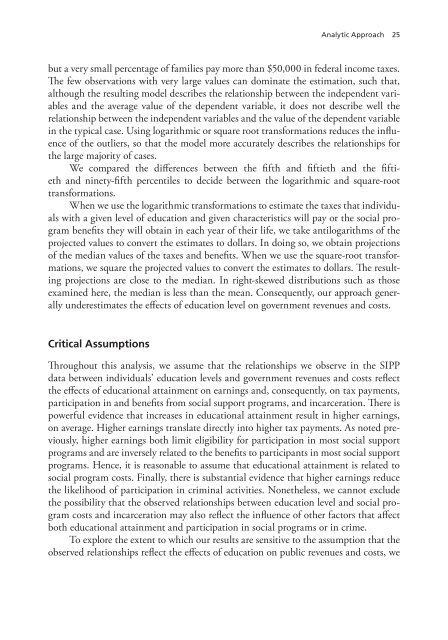The Benefits to Taxpayers from Increases in Students - RAND ...
The Benefits to Taxpayers from Increases in Students - RAND ...
The Benefits to Taxpayers from Increases in Students - RAND ...
You also want an ePaper? Increase the reach of your titles
YUMPU automatically turns print PDFs into web optimized ePapers that Google loves.
Analytic Approach 25<br />
but a very small percentage of families pay more than $50,000 <strong>in</strong> federal <strong>in</strong>come taxes.<br />
<strong>The</strong> few observations with very large values can dom<strong>in</strong>ate the estimation, such that,<br />
although the result<strong>in</strong>g model describes the relationship between the <strong>in</strong>dependent variables<br />
and the average value of the dependent variable, it does not describe well the<br />
relationship between the <strong>in</strong>dependent variables and the value of the dependent variable<br />
<strong>in</strong> the typical case. Us<strong>in</strong>g logarithmic or square root transformations reduces the <strong>in</strong>fluence<br />
of the outliers, so that the model more accurately describes the relationships for<br />
the large majority of cases.<br />
We compared the differences between the fifth and fiftieth and the fiftieth<br />
and n<strong>in</strong>ety-fifth percentiles <strong>to</strong> decide between the logarithmic and square-root<br />
transformations.<br />
When we use the logarithmic transformations <strong>to</strong> estimate the taxes that <strong>in</strong>dividuals<br />
with a given level of education and given characteristics will pay or the social program<br />
benefits they will obta<strong>in</strong> <strong>in</strong> each year of their life, we take antilogarithms of the<br />
projected values <strong>to</strong> convert the estimates <strong>to</strong> dollars. In do<strong>in</strong>g so, we obta<strong>in</strong> projections<br />
of the median values of the taxes and benefits. When we use the square-root transformations,<br />
we square the projected values <strong>to</strong> convert the estimates <strong>to</strong> dollars. <strong>The</strong> result<strong>in</strong>g<br />
projections are close <strong>to</strong> the median. In right-skewed distributions such as those<br />
exam<strong>in</strong>ed here, the median is less than the mean. Consequently, our approach generally<br />
underestimates the effects of education level on government revenues and costs.<br />
Critical Assumptions<br />
Throughout this analysis, we assume that the relationships we observe <strong>in</strong> the SIPP<br />
data between <strong>in</strong>dividuals’ education levels and government revenues and costs reflect<br />
the effects of educational atta<strong>in</strong>ment on earn<strong>in</strong>gs and, consequently, on tax payments,<br />
participation <strong>in</strong> and benefits <strong>from</strong> social support programs, and <strong>in</strong>carceration. <strong>The</strong>re is<br />
powerful evidence that <strong>in</strong>creases <strong>in</strong> educational atta<strong>in</strong>ment result <strong>in</strong> higher earn<strong>in</strong>gs,<br />
on average. Higher earn<strong>in</strong>gs translate directly <strong>in</strong><strong>to</strong> higher tax payments. As noted previously,<br />
higher earn<strong>in</strong>gs both limit eligibility for participation <strong>in</strong> most social support<br />
programs and are <strong>in</strong>versely related <strong>to</strong> the benefits <strong>to</strong> participants <strong>in</strong> most social support<br />
programs. Hence, it is reasonable <strong>to</strong> assume that educational atta<strong>in</strong>ment is related <strong>to</strong><br />
social program costs. F<strong>in</strong>ally, there is substantial evidence that higher earn<strong>in</strong>gs reduce<br />
the likelihood of participation <strong>in</strong> crim<strong>in</strong>al activities. Nonetheless, we cannot exclude<br />
the possibility that the observed relationships between education level and social program<br />
costs and <strong>in</strong>carceration may also reflect the <strong>in</strong>fluence of other fac<strong>to</strong>rs that affect<br />
both educational atta<strong>in</strong>ment and participation <strong>in</strong> social programs or <strong>in</strong> crime.<br />
To explore the extent <strong>to</strong> which our results are sensitive <strong>to</strong> the assumption that the<br />
observed relationships reflect the effects of education on public revenues and costs, we
















